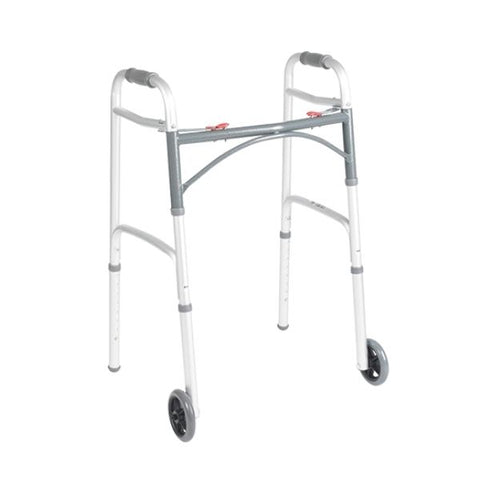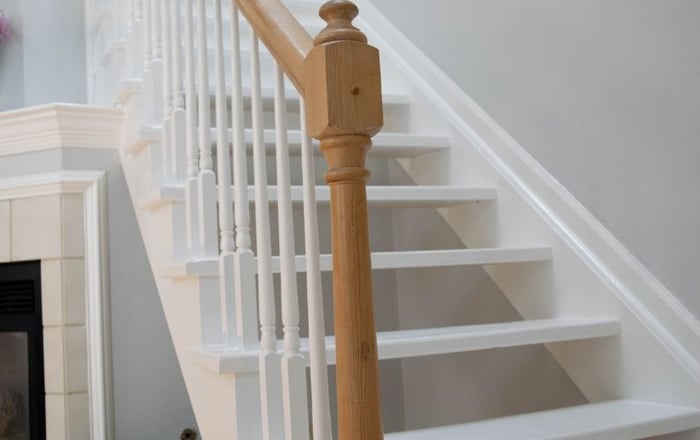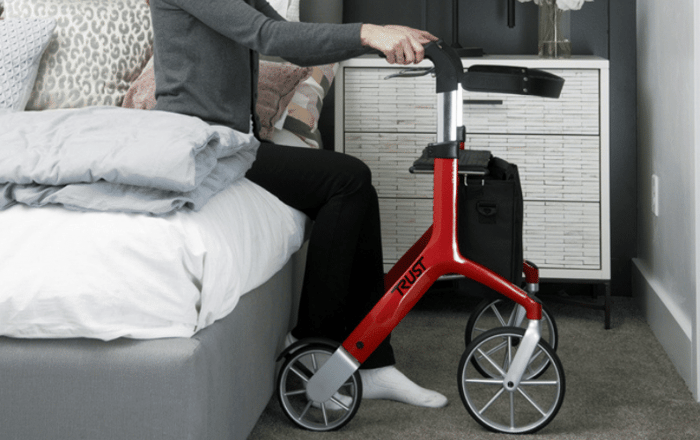Learn how to use a walker the right way with our step-by-step guide. Whether you're looking for product recommendations or tips for beginners, this post covers it all!
As we age, many of us will likely become good candidates for using a walker. That said, walkers aren’t reserved only for aging people. In fact, while thousands of people 65 and older use walkers, age isn’t the sole factor for determining whether a person needs one.
Walkers are designed for anyone who needs assistance with stability, balance, or range of motion issues.
You've likely watched people who look like they're doing great at living life with a walker. They probably didn't start out that way!
Mastering the use of a walker can be a bit challenging at first, but don't worry, we have additional resources to assist you.
- Types of Walkers: Which Walker if Right for You
- Great tips for Safely Exercising With a Walker
- How to Use a Walker, A Guide for Beginners
- How to Uses a Walker for Climbing Stairs
Read our guide and learn more about walking with a walker the safe way.
Your Guide to Using a Walker The Right Way
The Challenge of Standing
If you’ve never used a medical walker before, you’ll go through a breaking-in period where you figure out how to navigate your environment.
The first thing most people realize is how different it is to move from a sitting position to standing up. It won’t take long until you work out your system but here are a few hacks that should make things easier for you.
First, make sure you put on the brakes. This doesn’t only make the standing process easier, it prevents your feet from going out from under you if the walker moves unexpectedly.
Next, scoot to the edge of your chair until you’re comfortable. Toes should stay lined up with the edge of your chair. With one hand on your chair and the other on the walker, lean forward and put some (not all) of your body weight on your feet.
Now, you can use your legs to help you stand up. Take a minute and make sure you feel comfortable with your balance before you unlock the brakes.
Now that you’re standing, we’ll help you sit back down.
Transitioning from Standing to Sitting
Remember we said standing up with a walker requires a different set of movements than what you’re used to? Moving from standing to a sitting position is different too and it may feel awkward the first few times you try.
First, stand in front of your chair with the back of your legs not quite touching the chair. Move the walker slowly away from you and bend forward. Put the brakes on and then carefully reach behind and place your hands on the chair arms.
Next, use your legs and lower yourself in the chair. Slow is the name of the game with both standing and sitting back down.
Since you won’t spend all your time just standing and sitting, let’s look at actual walking.
Walking Through an Obstacle Course
The view from behind a walker often resembles an obstacle course, especially when you’re walking in an unfamiliar area.
When you’re at home, be on the lookout for moving obstacles like pets and children. Both have a tendency to pop up when you least expect it. Also, watch for items lying on the floor like clothes, boxes, and area rugs.
If you can, arrange the furnishings in your home so that you have enough room for navigating with your walker.
Consider placing a wheelchair ramp at your front and back door. Many people who don’t need wheelchairs but do use other mobility aids enjoy having a ramp at home.
When walking outside, always look ahead and keep your eyes peeled for uneven sidewalks and other hazards. Don’t worry about going slow—the world won’t pass you by—safety comes first.
Put Your Shoes On
Most people know they must always wear shoes when walking with a walker. But did you know there’s also the right type of shoe?
The best shoes are non-skid with rubber soles. You can wear sneakers or another style of low-heeled tie shoes. No high heels!
Depending on the climate where you live, you may need winter shoes or boots as well. For people who live in areas where winter brings ice and snow, consider a pair of shoe grippers. Shoe grippers act like cleats and slip right over your shoes.
Avoid smooth-soled shoes as they put you at risk of slipping. Also, don’t use a walker when your feet are bare or while wearing only socks.
Walker Safety in Bad Weather
The right shoes will help keep your feet on the ground but what about other weather-related risks?
If you live in a snowy country, you can reduce the risk of falls indoors if you make sure you wipe up any melting snow in entryways to your home. Keep snow cleared from walkways and if you have ramps going from doorways to the driveway, clear those too.
When walking with a walker outside, don’t get in a hurry. Also, keep an eye out for icy surfaces on sidewalks and driveways. Clear and even ground is your best friend during the snow and rainy season.
One in three people 65 and older fall every year. Things like poor eyesight, weakness, and medication can cause falls but so do slippery ground conditions. Don’t fear going out in bad weather, but do take the necessary precautions for staying safe with your walker.
Don’t Forget Walker Tune-Ups
A walker is like a machine and does better with routine maintenance. Here are a few tune-up tasks that should keep your walker in optimum working condition.
Check the tires (wheels). Remove any dirt and grime. Clean wheels roll better.
Inspect the rubber tips on the walker’s legs. Replace if they’re worn out or swap the tips for tennis balls. Do that and your walker will glide along more smoothly.
Make sure the brakes work if you have a walker with wheels. If the brakes aren’t in good working order, don’t use your walker until you can repair them.
Some models come with a built-in seat design to give you a brief rest. Some people use this type of walker like it’s a wheelchair. That’s dangerous as the walker could tip over and take you with it.
Excited to Get Started Using a Walker?
Hopefully, we’ve shown you that walkers aren’t only for aging people. They’re for anyone who needs assistance with mobility, no matter their age.
Standing and sitting while using a walker requires a few techniques but after a while, you’ll feel like a pro and can go just about anywhere you choose. With a few safety precautions and regular maintenance, your walker should be a reliable assistant.
If you have questions about walkers or our other medical products, contact us. We’re always happy to chat with you.
Finally, check out our wide assortment of walkers and rollators here.











